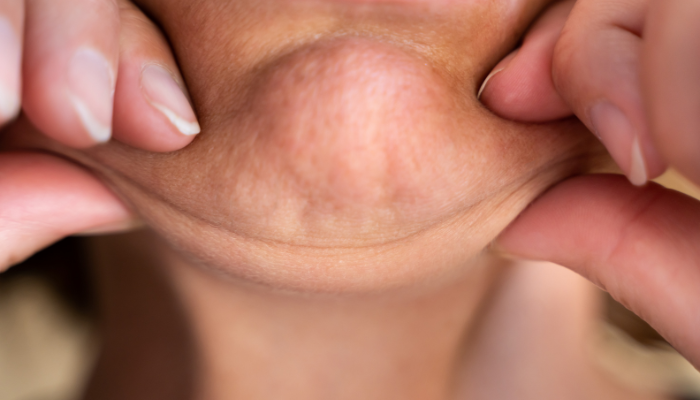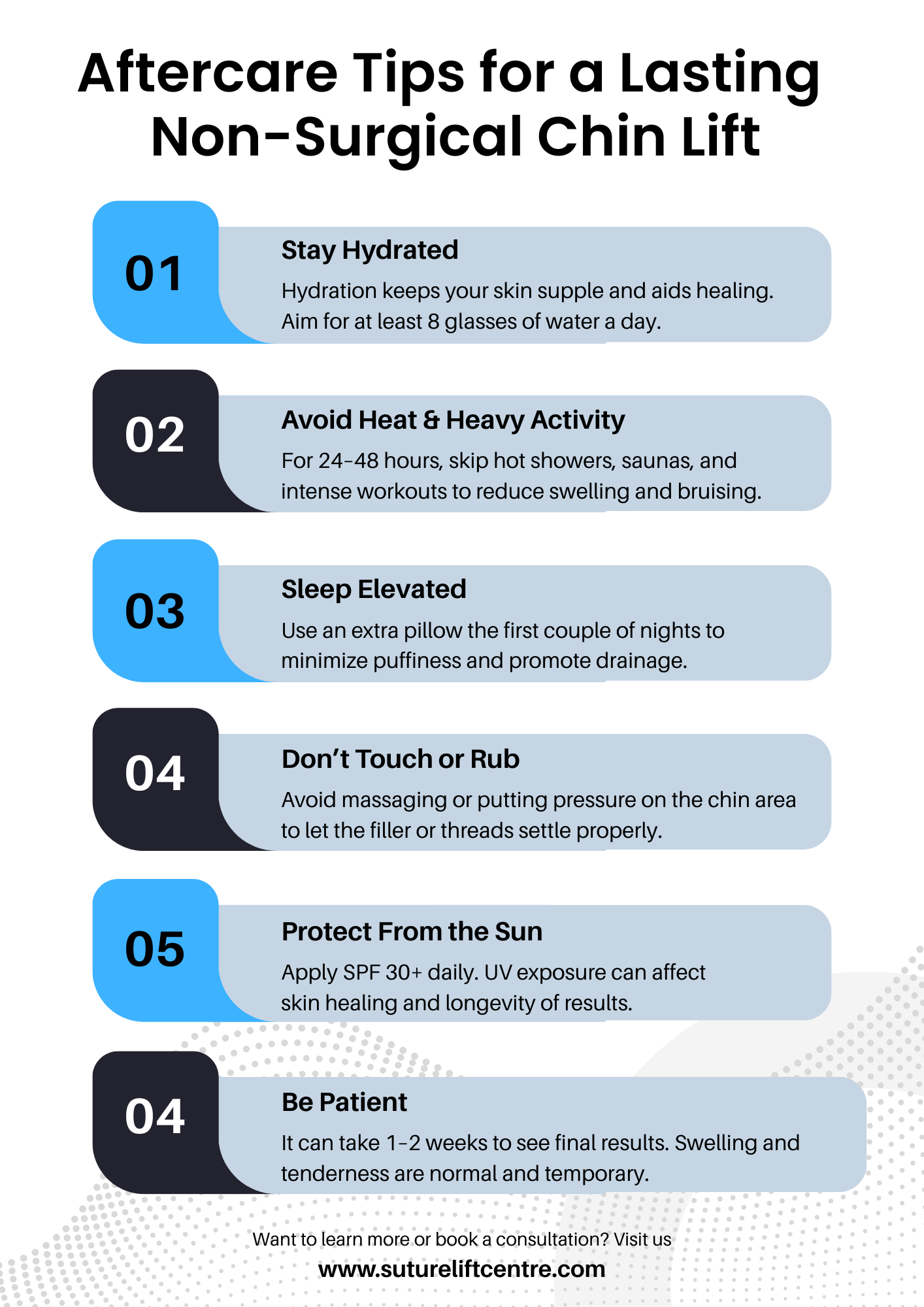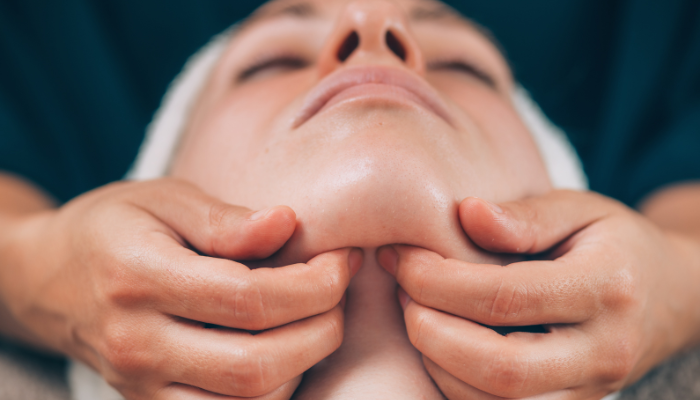What if you could lift and define your chin—without surgery? Suture lifts offer a subtle, non-invasive way to enhance your profile, using tiny threads instead of scalpels.
Whether you’re curious, cautious, or already clued in, this quick guide will reveal how a small tweak can make a big difference. Ready to see what a lift without the downtime really looks like? Let’s dive in.
Key Takeaways
- A non-surgical chin lift uses special methods to gently lift and shape your chin area without surgery.
- You can expect results that look natural and last a good while, making it a nice option for subtle improvements.
- It’s great for people who want a lift but don’t want the long recovery time that comes with traditional operations.
- Before you start, you’ll have a chat with a specialist to talk about what you want and what to expect.
- Looking after yourself properly after the procedure is super important for a smooth recovery and good results.
Understanding The Non-Surgical Chin Lift

Non-surgical chin lift is basically a way to redefine your chin and jawline without going under the knife. Instead of a full-on surgical facelift, specialists use special threads, or sutures, to gently lift and contour the area. It’s a great option if you’re starting to notice some sagging or just want a bit more definition without the risks and downtime of surgery.
How The Procedure Works
The procedure itself is pretty straightforward. It all starts with a consultation where you chat about what you’re hoping to achieve. The specialist will assess your face and map out the best approach. Once you’re both happy, a local anaesthetic is applied to keep you comfy.
Then, a few tiny incisions are made, and those special sutures are carefully inserted just under the skin. These sutures have little barbs or cones that grip onto the tissue, allowing the specialist to gently lift and reposition everything. After the lift is complete, the sutures are trimmed and the incisions are closed.
Key Benefits Of This Approach
So, why are more and more people opting for a non-surgical chin lift? Well, there are quite a few perks:
- It’s minimally invasive, meaning less pain and a quicker recovery.
- The results look natural, so you’ll still look like you, just a bit more refreshed.
- There’s minimal downtime, so you can get back to your life pretty quickly.
- It’s a good option if you’re not quite ready for surgery or if you just want a subtle enhancement.
- The procedure is relatively quick, often taking less than an hour.
A non-surgical chin lift offers a fantastic middle ground for those seeking noticeable improvements without the commitment of traditional surgery. It’s about enhancing your natural features in a subtle, yet effective way.
Benefits Of A Non-Surgical Chin Lift
Natural-Looking Results
One of the biggest draws of a non-surgical chin lift is how natural the results appear. It’s about subtle enhancement, not a dramatic overhaul. The sutures work with your existing facial structure to create a more defined and youthful look, without that ‘overdone’ appearance some associate with more invasive procedures. It’s like turning back the clock a little, but in a way that still looks like you.
Minimal Downtime And Recovery
Let’s be honest, who has weeks to recover from surgery these days? A non-surgical chin lift scores big points here. Most people can get back to their normal routines pretty quickly.
There might be some mild swelling or bruising, but it usually fades within a few days. You won’t need to take extended time off work, and you can get back to enjoying life without a long recovery period.
Addressing Ageing Concerns
As we get older, things start to sag a bit, and the chin and jawline are no exception. A non-surgical chin lift can be a great way to tackle these early signs of ageing. It can help to:
- Reduce the appearance of jowls
- Define the jawline
- Create a smoother contour
It’s not about completely erasing the years, but rather about subtly restoring a more youthful and defined appearance. It’s a way to feel more confident in your own skin without undergoing major surgery.
Preparing For Your Non-Surgical Chin Lift

Getting ready for a non-surgical chin lift is actually pretty straightforward. It’s not like prepping for a big operation, but there are still a few things you’ll want to do to make sure you get the best possible results.
Initial Consultation And Assessment
First things first, you’ll have a consultation with the specialist. This is where you get to chat about what you’re hoping to achieve and they can assess whether a non-surgical chin lift is right for you.
They’ll look at your chin and jawline, discuss your aesthetic goals, and explain the procedure in detail. Don’t be shy about asking questions – it’s your chance to get all the info you need.
What To Discuss With Your Specialist
Okay, so what should you actually talk about during your consultation? Well, pretty much anything that’s on your mind! But here are a few key things to cover:
- Your expectations: Be realistic about what a non-surgical chin lift can achieve.
- Your medical history: Let them know about any health conditions or medications you’re taking.
- Potential risks and complications: It’s good to be aware of these, even though they’re rare.
- The type of sutures they’ll be using: Different sutures can give slightly different results.
It’s also a good idea to bring photos of how you’d like your chin to look. This gives the specialist a clearer idea of your vision and helps them tailor the procedure to your needs.
Pre-Procedure Guidelines
In the days leading up to your treatment, there are a few things you’ll need to avoid to minimise the risk of complications. These might include:
- Blood-thinning medications: Like aspirin or ibuprofen.
- Alcohol: It can increase the risk of bruising.
- Smoking: It can impair healing.
- Certain supplements: Your specialist will give you a list of ones to avoid.
Basically, you want to be in the best possible shape for the procedure. Follow your specialist’s instructions carefully, and you’ll be well on your way to a more defined chin!
The Non-Surgical Chin Lift Procedure
One of the first things people ask is, “Will it hurt?” Well, the good news is that steps are taken to keep you comfortable. Usually, a local anaesthetic is applied to the area. This means you’ll be awake during the procedure, but you shouldn’t feel any sharp pain. You might feel some pressure or a bit of a tug, but it’s generally manageable.
Think of it like a visit to the dentist – a little bit of discomfort, but nothing too bad. If you’re particularly anxious, have a chat with your specialist beforehand; they can often offer options to help you relax.
The Role Of Sutures In Lifting
Sutures are the real heroes of a non-surgical chin lift. These aren’t your run-of-the-mill stitches; they’re specially designed threads with tiny barbs or cones. These little grips are what allow the specialist to lift and reposition the tissue under your chin.
The sutures are inserted through small incisions, and then gently pulled to create the desired lift. It’s a bit like scaffolding, providing support and structure to redefine your jawline. Over time, the sutures also stimulate collagen production, which helps to maintain the lift and improve skin elasticity.
It’s a clever combination of immediate results and long-term benefits.
Immediate Post-Procedure Experience
Right after the procedure, you’ll probably notice some changes straight away. There might be some mild swelling or bruising, but that’s totally normal and usually fades within a few days.
You’ll likely be given some aftercare instructions, like applying ice packs and avoiding strenuous activities.
It’s important to remember that everyone’s experience is different, but most people find the immediate post-procedure period quite manageable. You might feel a little tightness or tenderness, but it shouldn’t be severe. The key is to follow your specialist’s advice and be patient while your body heals.
Here’s a rough timeline of what to expect:
- Day 1-3: Mild swelling and bruising, some discomfort.
- Day 4-7: Swelling and bruising start to subside.
- Week 2: Noticeable improvement in chin definition.
Essential Aftercare Practises For Optimal Results

Your specialist knows your specific situation and what’s best for you. Stick to their advice like glue. They’ll give you personalised instructions on everything from cleaning the area to taking any medication. Don’t be tempted to skip steps or do your own thing – it could affect your results.
Managing Discomfort And Swelling
Okay, let’s be real, there might be some discomfort and swelling after the procedure. It’s totally normal and here’s what you can do:
- Cold Compresses: Apply cold compresses to the area for about 15-20 minutes at a time, several times a day, especially in the first 48 hours. This helps reduce swelling and ease any discomfort.
- Pain Relief: Over-the-counter pain relievers like paracetamol are usually fine, but double-check with your specialist first.
- Elevation: When you’re resting, try to keep your head elevated. This can also help minimise swelling.
Remember, everyone’s different, so what works for one person might not work for another. If you’re concerned about anything, don’t hesitate to contact your specialist.
Long-Term Care For Lasting Effects
So, you’ve nailed the initial aftercare, but what about the long game? Here’s how to keep those results looking great:
- Sun Protection: Sun is the enemy of good skin! Always wear sunscreen, even on cloudy days.
- Skincare Routine: Stick to a gentle skincare routine. Avoid harsh chemicals or abrasive scrubs that could irritate the area.
- Healthy Lifestyle: A healthy diet and regular exercise can do wonders for your skin and overall appearance. Plus, staying hydrated is key!
And finally, remember that results can vary, and it’s important to have realistic expectations. But with proper aftercare, you can enjoy your refreshed look for longer.
Who Is An Ideal Candidate For A Non-Surgical Chin Lift?
Generally, the best candidates are those who are experiencing mild to moderate sagging in the lower face and neck. This procedure is particularly effective for individuals who want to improve the definition of their jawline or reduce the appearance of a double chin without undergoing a full surgical facelift.
You might be a good fit if:
- You’re noticing early signs of ageing, such as slight jowling.
- You have good skin elasticity, which helps the skin conform to the new contours created by the sutures.
- You’re in good overall health and don’t have any conditions that could interfere with healing.
Realistic Expectations For Outcomes
It’s really important to have realistic expectations. A non-surgical chin lift can provide a noticeable improvement, but it won’t deliver the same dramatic results as a surgical facelift. It’s more about subtle refinement and rejuvenation.
Think of it as a gentle lift, not a complete transformation. If you’re looking for a significant change, surgery might be a better option. It’s all about understanding the limitations and benefits of the procedure.
It’s worth remembering that the results of a non-surgical chin lift are influenced by factors like your skin type, age, and lifestyle. While the procedure can provide a lasting improvement, the effects aren’t permanent, and you may need maintenance treatments over time.
Considering Your Aesthetic Goals
Ultimately, the decision to undergo a non-surgical chin lift should align with your personal aesthetic goals.
- What are you hoping to achieve?
- Do you want a more defined jawline?
- Are you trying to reduce the appearance of a double chin?
- Or are you simply looking for a subtle refresh?
Discuss your goals with a qualified specialist. They can assess your facial structure, skin quality, and overall health to determine if a non-surgical chin lift is the right approach for you. They can also help you understand what kind of results you can realistically expect and tailor the treatment to meet your specific needs.
Here’s a quick checklist to help you consider your aesthetic goals:
- Define your specific concerns (e.g., sagging jawline, double chin).
- Visualise your desired outcome (e.g., a more sculpted profile).
- Discuss your expectations with a qualified practitioner.
Conclusion
A non-surgical chin lift, like the chin suture lift, really does offer a good way to get a fresher look without all the fuss of a big operation. It’s a gentle option, and it can make a real difference for your lower face. If you’re thinking about it, just remember to chat with a specialist.
They can help you figure out if it’s the right thing for you and what to expect. It’s all about finding what works best for you to feel good about how you look.
Frequently Asked Questions
What exactly is a non-surgical chin lift?
A non-surgical chin lift uses special threads, called sutures, that are gently put under your skin. These threads subtly pull up and reshape your chin and jawline, giving you a fresher look without needing a big operation.
How long does the procedure typically take?
The procedure is quite quick! It usually takes less than an hour. You’ll have a local anaesthetic so you won’t feel any pain, and then the specialist will carefully place the threads. It’s often called a ‘lunchtime lift’ because it’s so fast.
What's the recovery like after a non-surgical chin lift?
One of the best things about this lift is that you don’t need much time off. You might have a little swelling or bruising for a couple of days, but most people can get back to their usual activities, like work or seeing friends, very quickly.
How long do the results of a non-surgical chin lift last?
The results can last for a good while, often several years. The threads also help your body make more collagen, which is good for your skin and helps the lifted look last longer. It’s not a permanent change, but it’s certainly not a quick fix either.
Am I a good candidate for this type of chin lift?
This treatment is great for people who are starting to notice a bit of sagging around their chin or jawline but don’t want full surgery. It’s also good if you want a more defined look. Your specialist will help you figure out if it’s right for you.
What should I do to prepare for the treatment?
Before your procedure, you’ll have a chat with your specialist to talk about what you want to achieve. They’ll give you specific advice, which might include avoiding certain medicines or supplements for a short time. It’s all about making sure you’re ready and comfortable.




